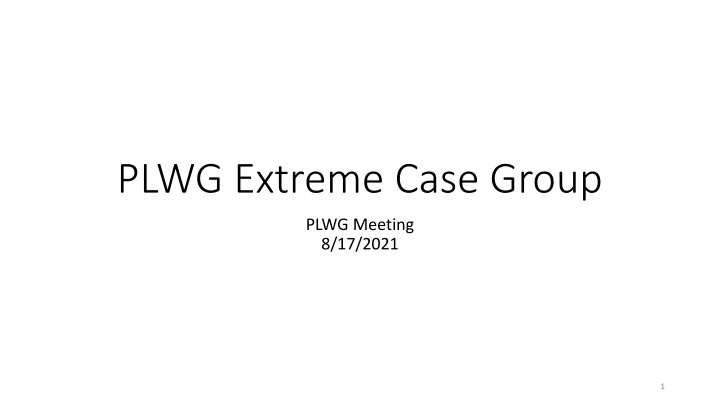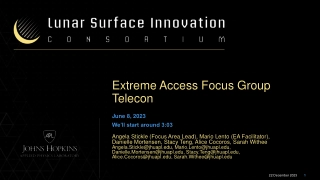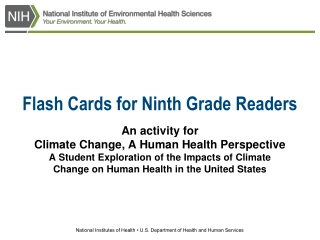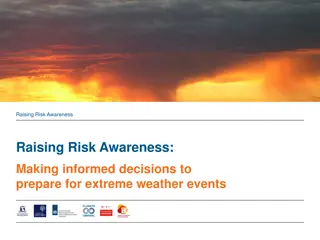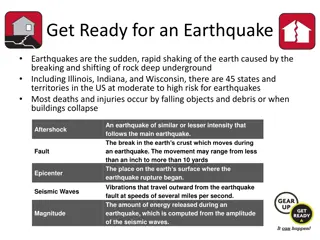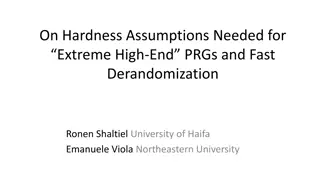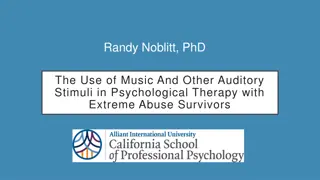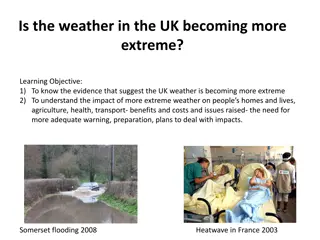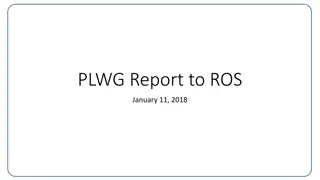PLWG Extreme Case Group
Reasons for extreme cold case development and proposed new cases in power system planning are discussed, including identifying critical facilities, extreme weather scenarios, and case examples for analysis.
Download Presentation

Please find below an Image/Link to download the presentation.
The content on the website is provided AS IS for your information and personal use only. It may not be sold, licensed, or shared on other websites without obtaining consent from the author.If you encounter any issues during the download, it is possible that the publisher has removed the file from their server.
You are allowed to download the files provided on this website for personal or commercial use, subject to the condition that they are used lawfully. All files are the property of their respective owners.
The content on the website is provided AS IS for your information and personal use only. It may not be sold, licensed, or shared on other websites without obtaining consent from the author.
E N D
Presentation Transcript
PLWG Extreme Case Group PLWG Meeting 8/17/2021 1
Reasons for Extreme Cold Case Development Non-deliverability is a resource adequacy and transmission planning problem that is not directly addressed by current modeling efforts. Can we identify generation and transmission facilities that are critical to the operation of the ERCOT System during extreme load and weather events? We know from transmission system studies that certain generators and transmission lines are more important to maintaining adequate voltage profiles and line flows. This new planning case or process would help identify load or generation pockets susceptible to correlated generation or transmission failures. Critical generation facilities could have more stringent winterization requirements and resiliency measures (e.g., on-site fuel supplies). Generation facilities include all units in a single physical location, or all units served by the same fuel supply (e.g., gas pipeline). Critical transmission facilities could have requirements that they be hardened against higher wind speeds, more extreme temperatures, or greater ice loadings (for example). 2
Proposed New Cases / Extreme Events New Case Case Description Extreme cold Statewide less than 20 degrees Fahrenheit Extreme heat Statewide greater than 105 degrees Fahrenheit Extreme drought Statewide extended lack of rainfall Extreme heat and drought Combination of extreme heat and drought scenarios Tornadoes More likely standalone in the North portion of the system Hurricanes/Tropical Storms More likely on the coastal side of the system (e.g. Ike, Harvey) 3
Example of Extreme Cold Case Development Case could use assumptions that proposed for a very cold winter morning with 0% solar and 10% wind and all available thermal generators dispatched to their maximum. Load would be not scaled down to match generation. Do we allow load shed as an option? Do we assume that new load products are part of the solution? Study would be a G1N1 or GXN1 analysis, where the GX is a group of generation facilities in the same physical area or with a common failure mode (e.g., gas pipeline). Houston and Valley Import (e.g., Hurricane Hanna) constraints may be of particular interest in this analysis. 4
NG, Coal, Wind, and Solar Gen in ERCOT in Feb 2021 Source: EIA 930 6
NG, Coal, Wind, and Solar Gen in SPP in Feb 2021 Source: EIA 930 7
NG, Coal, Wind, and Solar Gen in MISO in Feb 2021 Source: EIA 930 8
Daily NG Gen in ERCOT, SPP and MISO in Feb 2021 Source: EIA 930 9
Extreme Winter Case 6 am time period February 15, 2021 Weather Assumptions Load would be not scaled down to match generation Solar generation at 0% Wind generation at 10% One study would be a G1N1 or GXN1 analysis, where the GX is a group of generation facilities in the same physical area or with a common failure mode (e.g., gas pipeline) Another study would be systemwide natural gas fired deration of XX% to be reflective of natural gas system not pressurized appropriately 10
Other items discussed the group What duration of events should we be planning? Identify evidence whether the existing ERCOT market structure is working to handle extreme weather scenarios Does ERCOT have the tools they need? Additional educational ideas Many customers and market participants have renewables / zero carbon goals that shouldn t necessarily be ignored as technology is available for more reliable renewable energy sources, e.g. hydrogen fired generation. 11
What duration of events should we be planning? Do we have a normal expected duration that we are planning? Storm Uri in February 2021 could be described as a 96 hour event. Most events are locational specific (e.g. Harvey) but could also occur over a longer duration. Most summer time events will occur for less than 4 hours. But could occur longer due to major pipelines being shutdown or extended weather lulls (e.g. low wind, fires could created cloud cover for solar generation). Is it a small or large event? Can the outages be rotated? 12
Identify evidence whether the existing ERCOT market structure is working to handle extreme weather scenarios Not a topic of PLWG Being discussed at PUC Texas currently 13
Does ERCOT have the tools they need? Natural gas issues ERCOT does not currently have natural gas analysis tools from operational to planning to model and understand the natural gas markets Does ERCOT need these tools? Building a single ERCOT planning model (not segmented out) Can such a model be built out and solved? The answer may include coordinated load shed as the ultimate solution. Can ERCOT work with the REPs, municipals, cooperatives, and industrials to identify orderly load shed? Not a PLWG issue, but needs to be addressed by some ERCOT group If not, can we prepare a document identifying how load shed would be accomplished? 14
Additional education ideas Invite MISO Gas Electric Coordinator to speak to PLWG Invite Dr. Sinnott Murphy to present the work that he is doing with NREL regarding temperature-dependent models for generator failures and recoveries. He wrote a paper that shows that all generator types perform worse in very cold and very hot weather than recognized under current modeling practice. 15
Next Steps and Outstanding Questions Develop assumptions for other Extreme cases beyond winter How do these assumptions differ from TPL1-004? What venues should some of the other topics we discussed? 16
Appendix 17
Items from the Roadmap #9 Improve the assessment and communication of extreme low-probability, high-impact weather scenarios, including temperatures, durations, precipitation, humidity, and wind. Propose updated methodologies for the Seasonal Assessment of Resource Adequacy (SARA) for the ERCOT Region and other resource adequacy studies. This will improve public awareness about the potential high impacts of low-probability severe situations. #16 Improve and expand toolsets to manage short-supply situations. This includes facilitating additional voluntary load reductions and procuring additional ancillary or reliability services from resources with unique capabilities to operate during extreme weather conditions. #18 Initiate a process, both at ERCOT and the PUC, to address the Lower Rio Grande Valley transmission limitations, up to and including the construction of new transmission capacity. This will provide increased market access for resources in the Valley, improving reliability for customers during both normal conditions and high-risk winter events. #53 Improve system planning, including localized and regional significant growth patterns. This will improve the range of conditions considered in planning studies. #57 Consider on-site fuel supply including contracts with remote secured supplies. 18
Members John Bernecker (ERCOT) Doug Evans (STEC) Andrew Hamann (LCRA) Kevin Hanson (National Grid) Brian Hithersay (BEPC) Lori Simpson (Exelon) Mina Turner (AEP) Monica Walker (GM) 19
